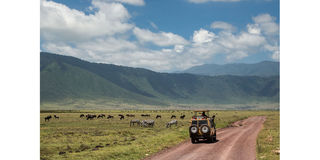Tap heritage resources, AWHF urges Tanzania

Ngorongoro crater
What you need to know:
- This emerged here yesterday at the start of an international conference on world heritage properties
Arusha. Tanzania has been challenged to tap the full potential of its spectacular heritage resources. Numerous sites of outstanding universal value found in the country can immensely boost tourism.
They can also elevate the country’s status in the community of nations in research and knowledge generation.
This emerged here yesterday at the start of an international conference on world heritage properties.
“Tanzania has the highest number of world heritage sites,” said Souayibou Varissou, the executive director of African World Heritage Fund (AWHF).
The country, he said, has also been active in preservation of its cultural relics and unique natural resources.
The two-day conference has been convened to empower the heritage professionals from the African continent.
Mr Varissou said with its diverse heritage resources, Tanzania should ensure they benefited its economy and knowledge generation.
The Fund was launched in 2006 to support effective conservation and protection of natural and cultural heritage in the continent. The focus, however, is on the heritage resources within Africa “that have outstanding universal value”.
The Fund also assists the African countries in implementing the 1972 World Heritage Convention.
AWHF was created to assist countries to expand their heritage properties “and sustain these wonderful places.”
Opening the conference, the minister for Natural Resources and Tourism Pindi Chana said Tanzania was committed to the protection of the heritage sites.
“We have some of the most spectacular places (sites) on earth,” she said, noting that the government was aware of their benefits to the economy.
“Heritage sites offer tourist attractions,” she said, adding that they must be well protected to achieve the goal.
However, Dr Chana decried little awareness of the world heritage properties among the policy makers in the country.
“There is little awareness and information on the importance of preserving them,” she told the meeting of heritage professionals from across Africa. The world heritage properties found in Tanzania – mainly the national parks, nature reserves and historical sites - will attract more visitors “if they are well protected and promoted.”
Tourism currently accounts for 17 percent of the country’s GDP and about 1.5 million direct jobs besides leading in forex generation.
In order to promote the significance of the heritage resources, the minister challenged the African countries to create heritage training hubs.
The Unesco-designated sites in Tanzania include three national parks; Serengeti, Kilimanjaro and Nyerere and the Ngorongoro Conservation Area (NCA).
Others are the Zanzibar Stone Town, the Kilwa Kisiwani-Songo Mnara ruins and the Kondoa Rock Art in Dodoma region.
NCA has three to four sites within; being its famous crater, Oldonyo Lengai volcanic mountain and the Laetoli and Olduvai Gorge archaeological sites.
An official of the Chinese embassy in Tanzania Mr Suo Peng lauded the Unesco for spearheading the conservation and development of the sites.
He called on the African countries to further invest in the protection and promotion of the sites of outstanding universal value for economic gains.




